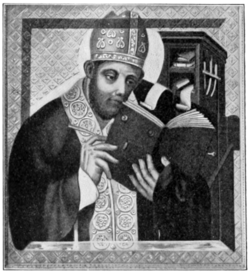army in Italy. To conciliate the King, Julius made d'Amboise "Legate a latere" for the whole of France, a most exceptional honour. Cardinal d'Amboise held his high office in Church and State till his death, which took place at the convent of the Celestins in Lyons, 25 May, 1510. He has a splendid tomb in the Cathedral of Rouen.
Legendre, Vie du cardinal d'Amboise (Rouen, 1726); Montbard, Le cardinal G. d'Amboise, ministre de Louis XII (Limoges, 1879); d'Amboise, Lettres au roi Louis XII (Brussels, 1712).
Ambronay, Our Lady of, a sanctuary of the Blessed Virgin at Ambronay, France, regarded as one of the two cradles of devotion to Our Lady in the Diocese of Belley. The original church was founded by recluses in the seventh century, and having been destroyed by the Saracens, was rebuilt (c. 803) by St. Barnard (778–842), together with the famous monastery of the same name. About the middle of the thirteenth century the church was reconstructed on a grander scale, and still remains, in spite of the ravages of 1793, one of the most imposing monuments of the diocese, remarkable for its windows, sacristy, altar, and spiral staircase. The façade of one of the naves dates from the ninth century.
Acta SS., 23 Jan.; Leroy, Histoire des pèlerinages de la Sainte Vierge en France (Paris, 1875), II, 185.
Ambros, August Wilhelm, historian of music and art critic, one of the greatest in modern times, b. at Mauth, near Prague, in Bohemia, 17 November, 1816; d. in Vienna, 28 June, 1876. Although destined for the profession of law, in which he obtained the doctor's degree, and advanced to the point of becoming Councillor of State, he studied music seriously and under the best auspices. He was soon appointed a member of the board of governors of the Royal Conservatory at Prague, and became active as a musical critic. At this period of his career Ambros wrote several overtures for orchestra and a "Stabat Mater." As a composer he reflected very strongly the influence of Robert Schumann. Lacking the vital spark of originality, his compositions have not survived him. He became generally known as an art critic through his book "Die Grenzen der Musik und Poesie," written in reply to Edward Hanslick's treatise "Vom Musikalisch-Schönen." The latter assumed a materialistic basis for the art of music, defining musical forms as being nothing more than "sounding arabesques." Ambros's work defines what can be expressed by means of music, and what needs one of the other arts for its manifestation. In this remarkable book the author not only lays down the principles of Catholic philosophy in the light of which he judges the art works of the past and present, but he also displays that extensive knowledge of the architecture, the sculpture, the painting, and the literature of all schools and nations, their inter-relation and common origin which at once attracted the attention of the scientific world. With every new work of Ambros, such as "Kulturhistorische Bilder aus dem Musikleben der Gegenwart," "Bunte Blätter" and numerous magazine articles, his reputation increased, until the Breslau publisher Leuckart (now in Leipzig) induced him to write a complete history of music. Ambros embraced with alacrity this great opportunity for, as he put it, "rendering a service to science and art." The result was the greatest historical work on the art of music in existence. Beginning with the music of antiquity in the first volume, the second is devoted to the Middle Ages, the third to the Netherland school, and the fourth deals with Palestrina and the transitions to the moderns. This history, revealing the great artistic past of the Church, appeared at the time of the revival brought about by the publication of Proske's "Musica Divina," and gave tremendous impetus to the movement. Proske made the treasures of polyphonic art accessible, and Ambros told of their origin. Aside from the permanent historical value of his work, Ambros has rendered the Catholic cause untold service by vindicating the past, and by proclaiming with a powerful pen and with vast erudition sound philosophic principles in the midst of a well-nigh all-pervading pantheism. Ambros died before completing the fourth volume of his history. Otto Kade published, in 1882, a fifth volume consisting of musical illustrations collected from the historian's literary remains, and W. Langhans has brought the history up to date, without, however, showing Ambros's acumen or soundness. It should be mentioned that Ambros, while holding his official positions in Prague and, after 1872, in Vienna, as an officer of the Department of Justice, professor at the Conservatory, and private tutor to Prince Rudolf, was given leave of absence six months in the year, and provided with the means to enable him to visit the principal libraries of Europe in search of material for his great work.
Reimann, Musiklexikon; Kornmüller, Lexikon der kirchlichen Tonkunst.
Ambrose, Saint, Bishop of Milan from 374 to 397; b. probably 340, at Trier, Arles, or Lyons; d. 4 April, 397.

St. Ambrose from a mural painting, Castle of Karlstein, Bohemia
He was one of the most illustrious Fathers and Doctors of the Church, and fitly chosen, together with St. Augustine, St. John Chrysostom, and St. Athanasius, to uphold the venerable Chair of the Prince of the Apostles in the tribune of St. Peter's at Rome. The materials for a biography of the Saint are chiefly to be found scattered through his writings, since the "Life" written after his death by his secretary, Paulinus, at the suggestion of St. Augustine, is extremely disappointing. Ambrose was descended from an ancient Roman family, which, at an early period had embraced Christianity, and numbered among its scions both Christian martyrs and high officials of State. At the time of his birth his father, likewise named Ambrosius, was Prefect of Gallia, and as such ruled the present territories of France, Britain, and Spain, together with Tingitana
